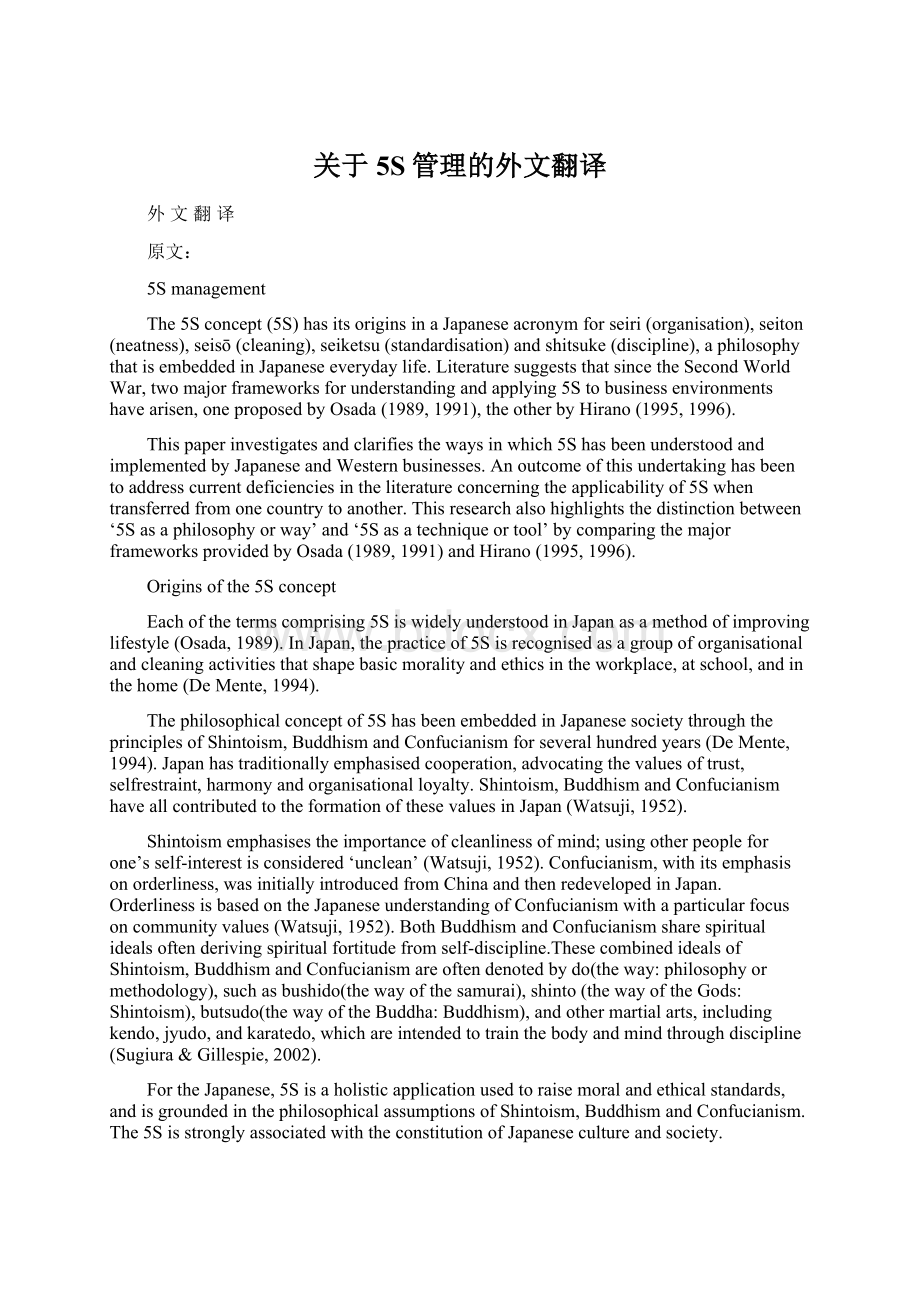 关于5S管理的外文翻译Word下载.docx
关于5S管理的外文翻译Word下载.docx
- 文档编号:18624230
- 上传时间:2022-12-29
- 格式:DOCX
- 页数:8
- 大小:69.53KB
关于5S管理的外文翻译Word下载.docx
《关于5S管理的外文翻译Word下载.docx》由会员分享,可在线阅读,更多相关《关于5S管理的外文翻译Word下载.docx(8页珍藏版)》请在冰豆网上搜索。

Thispaperinvestigatesandclarifiesthewaysinwhich5ShasbeenunderstoodandimplementedbyJapaneseandWesternbusinesses.Anoutcomeofthisundertakinghasbeentoaddresscurrentdeficienciesintheliteratureconcerningtheapplicabilityof5Swhentransferredfromonecountrytoanother.Thisresearchalsohighlightsthedistinctionbetween‘5Sasaphilosophyorway’and‘5Sasatechniqueortool’bycomparingthemajorframeworksprovidedbyOsada(1989,1991)andHirano(1995,1996).
Originsofthe5Sconcept
Eachofthetermscomprising5SiswidelyunderstoodinJapanasamethodofimprovinglifestyle(Osada,1989).InJapan,thepracticeof5Sisrecognisedasagroupoforganisationalandcleaningactivitiesthatshapebasicmoralityandethicsintheworkplace,atschool,andinthehome(DeMente,1994).
Thephilosophicalconceptof5ShasbeenembeddedinJapanesesocietythroughtheprinciplesofShintoism,BuddhismandConfucianismforseveralhundredyears(DeMente,1994).Japanhastraditionallyemphasisedcooperation,advocatingthevaluesoftrust,selfrestraint,harmonyandorganisationalloyalty.Shintoism,BuddhismandConfucianismhaveallcontributedtotheformationofthesevaluesinJapan(Watsuji,1952).
Shintoismemphasisestheimportanceofcleanlinessofmind;
usingotherpeopleforone’sself-interestisconsidered‘unclean’(Watsuji,1952).Confucianism,withitsemphasisonorderliness,wasinitiallyintroducedfromChinaandthenredevelopedinJapan.OrderlinessisbasedontheJapaneseunderstandingofConfucianismwithaparticularfocusoncommunityvalues(Watsuji,1952).BothBuddhismandConfucianismsharespiritualidealsoftenderivingspiritualfortitudefromself-discipline.ThesecombinedidealsofShintoism,BuddhismandConfucianismareoftendenotedbydo(theway:
philosophyormethodology),suchasbushido(thewayofthesamurai),shinto(thewayoftheGods:
Shintoism),butsudo(thewayoftheBuddha:
Buddhism),andothermartialarts,includingkendo,jyudo,andkaratedo,whichareintendedtotrainthebodyandmindthroughdiscipline(Sugiura&
Gillespie,2002).
FortheJapanese,5Sisaholisticapplicationusedtoraisemoralandethicalstandards,andisgroundedinthephilosophicalassumptionsofShintoism,BuddhismandConfucianism.The5SisstronglyassociatedwiththeconstitutionofJapanesecultureandsociety.
Theuseof5SasastrategyforachievingbusinessexcellencehasbeenevidentinJapansincetheSecondWorldWar(DeMente,1994).Initially,variousplantmaintenanceconcepts(preventive,periodic,predictiveandcorrectivemaintenance)wereimportedtoJapanfromtheUS(Nakajima,1988).TheconceptofQualitywasalsointroducedfromtheUStoJapanbySarasohn,Deming,andJuran,fromthelate1940stotheearly1950s(Dean,2005;
Foley,2000).Aninnovativeapproachtototalproductivemaintenance(TPM)wasdevelopedinJapanduringthisperiodand5SwasactivelyutilisedatNippondenso(Nakajima,1988)asaplatformforTPMimplementation.Later,5SwasintegratedwithKAIZEN(continuousimprovement)philosophy(Imai,1986)thenimplementedatToyotaMotorCorporationaspartoftheirproductionsystem,namelyToyotaProductionSystem(TPS).The5ShasalsobeenwidelyusedinTQMsystemswhereithasbeenreferredtoaspartofaseriesofqualityinitiatives(ShariMohd&
Aspinwall,2001),agoodhousekeepingtool(Ahmed&
Hassan,2003;
Chin&
Pun,2002),aneffectivecleanlinessprogram(Tannocketal.,2002)andasystemformaintainingagoodworkingenvironment(Ho,1999;
Krasachol&
Tannock,1999).
Osada’sviewof5S:
asaphilosophyforlifeandbusiness
AccordingtoOsada(1989),5SisafundamentalpartofJapanesecultureandsociety.Forbothindividualsandorganisations,5Sengagesimprovementactivitiesinanyenvironment,includinghomes,schools,communitiesandworkplaces,regardlessofsizeortype.Theimplementationof5Scanuncoverhiddenproblemsthatmayotherwiseremainunnoticed.Thebenefitsofimplementing5Saresummarisedasfollows.
Cleanliness–tomaximiseeffectiveness,contributetoahealthierlifeandreducecrime(duetoenhancedtransparency);
Orderliness–tomaximiseefficiencyandeffectiveness,reducepeople’sworkload,reducehumanerrors(duetosimplifyingprocesses);
Discipline–toincreasethelevelofmoralityandethicsandtoincreaseminimumstandardsthroughtrainingandeducation.
Intheworkplace,5Sisused‘toorganisetheworkplace,tokeepitneat,toclean,tomaintainstandardisedconditions,andtomaintainthedisciplinethatisneededtodoagoodjob’(Osada,1991,p.x).Thepracticeof5Sincreases‘transparency’inanorganisationensuringagoodfirstimpressionoftheworkplacebyvisitors,particularlypotentialnewcustomers.Thesuccessfulimplementationof5Sincreasesnotonlyefficiency,suchasinproductivityandthelevelofqualitypercost,butalsoorganisationaleffectivenessthrough‘thesynergetic(orcooperative)effect’(Osada,1991,p.1),whichisoftenutilisedinteamsports.Thismeansthatthecontributionofindividualtalentandeffortbyeachteammemberoftenexceedstheperformancelevelofanysinglestandoutplayer.The5Sprogramalwaysemphasisestotalparticipation,sincethe‘synergeticeffect’createsstrongworkplacecommitmentfororganisationalimprovementactivities(Osada,1991).Insummary,5SisconceptualisedandimplementedinJapanesebusinessesasameansofachievingbusinessexcellence.
Inlinking5Swiththeworkplace,Osada(1991)providesthefollowingdefinitionsanddescriptionsforeachoftheactivities.Theorderoftheactivitiesisnotimportantbuttheyareallarelinkedandimplementedconcurrentlyandcyclically(seeFigure1).
Figure1
Hirano’sviewof5S:
asatechniqueortool
Hirano(1995,1996)developedanalternativeversionof5SduringthesameperiodasOsada,butwithamorepracticalfocus.Hirano(1995,p.28)explainsthesignificanceof5Sasatoolfor‘corporatesurvival’thatenablesjust-in-time(JIT)production,ratherthanawayofguidingaction.
Hirano(1995,1996)placedemphasisspecificallyonthefirsttwocomponentsof5S,seiri(organisation)andseiton(orderliness–usinghisinterpretation).Seiriissortingoutneededitemsfromunneededonesanddisposingofthelatter,whileseitonisprioritisingneededitems.Theotherthreecomponentsof5SareexplainedinasimilarwaytoOsada(1989,1991).Hirano(1995)suggeststhat5Sshouldbepromotedbytopmanagementusingthefollowingsteps.
(1)Establishanorganisationthatpromotes5S:
thisshouldbedonebytopmanagementandbeoperatedcompanywide.
(2)Establisha5Spromotionplan:
schedulingimplementationactivities.
(3)Create5Scampaignmaterials:
topmanagersshouldparticipateatthisstage.
(4)In-houseeducation:
answeringthequestionof‘Whatdoes5Smean?
’andprovidingtraining.
(5)5SImplementation:
usingvisualmethods,suchasred-taggingforseiri(organisation)andthesignboardstrategyforseiton(orderliness).
(6)5Sevaluationandfollow-up:
periodicevaluationtocheck,maintainandimprove5Sconditions.
Japantendstoperceive5Sasbothnecessaryandimportant.TheUSappearslikelytorecognizeitasimportantbutnotnecessary.Theresultsshowedthatthefrequencyofthemeasuredcomponent‘important’inJapanandtheUSwashigherthanintheUK.TheUKtendstoperceivethat5Sdoesnotrequireworkcommitment,employingtheword‘should’morethanJapanandtheUS.ThisindicatesthattheUKsees5Sasadirectiveratherthananenabler.
Japanemployed‘machine’morethantheUKandUS,whiletheUKandUSused‘items’morefrequently.ThereweresomesimilaritiesbetweenJapanandtheUS;
bothcountriesemployed‘information’and‘workplace’morethantheUK.Allcountriesused‘equipment’similarly.Theuseoffouroutoffiveconceptualwordswassignificantlydifferent.
Thereweresomesimilaritiesanddifferencesintheuseofobject-relatedwordsbetweenJapan,theUKandtheUS.Allthecountriesstudiedagreedthatworkequipmentismorewell-organisedandcleanasaresultof5Simplementation.TheUSandJapantendtoconsider5Sasalsodealingwithinformationandtheworkplace.InJapan,machinesarebetterorganizedandcleanedusing5S.
TheresultsshowedthattheUKandUSused‘item’morethanJapan.Thisindicatesthatthesecountriestendtoconsiderseiri(organisation)tobeaveryimportantcomponentin5S.Asseiriisthefirstcomponentof5Sandinvolvesanactofdisposingofunneededitemsasaresultoforganizationactivities,theUKandUSarelikelytoconsiderthatthefirstSseirishouldbeemphasizedthemost,ratherthanfocusingonallitemsasaholisticstrategy.
Discussion
Theinitialthematicanalysisindicatedaconsensusintheimprovementoftheworkenvironmentutilising5Sacrossallcountries.However,analysisofthemainthemebycountryhasshowndifferentoutcomes.Forexample,Japanesewebpagesemphasised‘improvement’themost,afocusonmoreefficientandeffectivebusinessperformance.IntheUKandUS,5Swasdirectlyrelatedto‘work’.Inotherwords,theperceptionof5SintheUKandUSwaslikelytobelimitedtoawork-relatedconcept,asopposedtotheJapaneseinterpretationthat5Sis
- 配套讲稿:
如PPT文件的首页显示word图标,表示该PPT已包含配套word讲稿。双击word图标可打开word文档。
- 特殊限制:
部分文档作品中含有的国旗、国徽等图片,仅作为作品整体效果示例展示,禁止商用。设计者仅对作品中独创性部分享有著作权。
- 关 键 词:
- 关于 管理 外文 翻译
 冰豆网所有资源均是用户自行上传分享,仅供网友学习交流,未经上传用户书面授权,请勿作他用。
冰豆网所有资源均是用户自行上传分享,仅供网友学习交流,未经上传用户书面授权,请勿作他用。


 对中国城市家庭的教育投资行为的理论和实证研究.docx
对中国城市家庭的教育投资行为的理论和实证研究.docx
